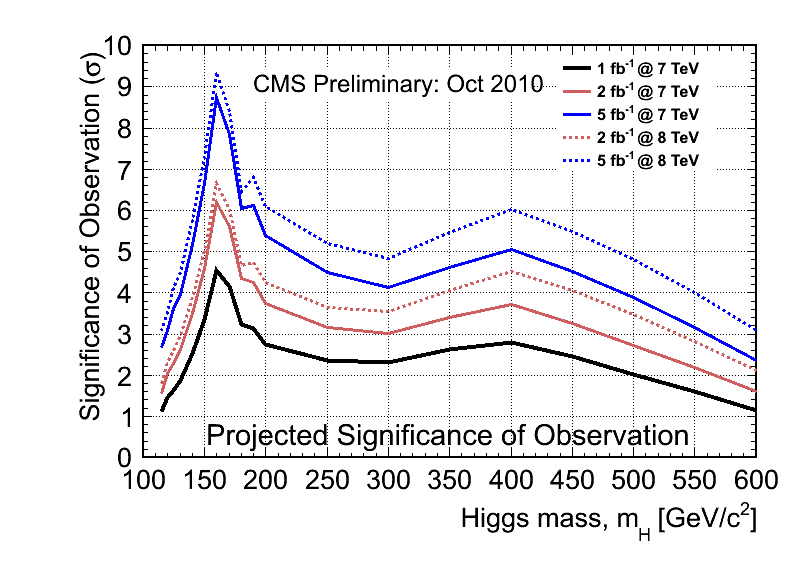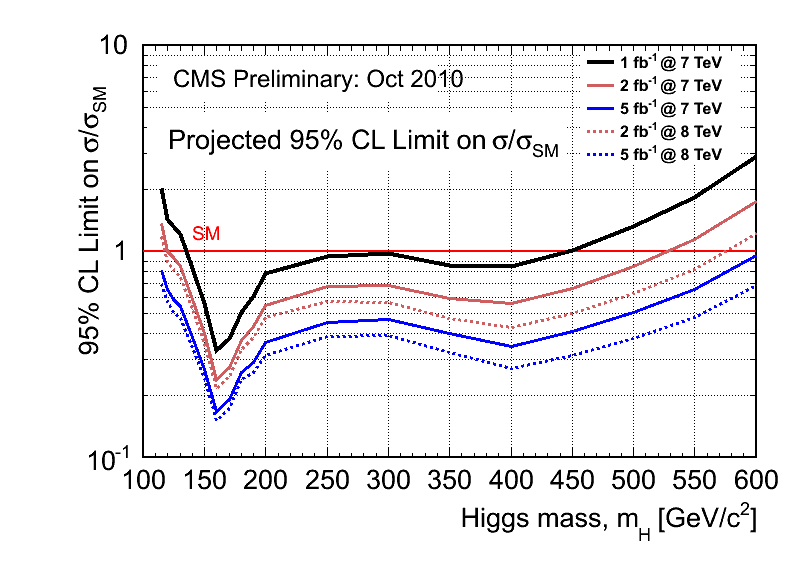Previously, for 2012 a long shutdown had been foreseen, to allow the retro-fitting of LHC with systems which will prevent future incidents such as the one of September 2008. The possibility that ATLAS and CMS would only get about one inverse femtobarn worth of proton-proton collisions in 2011, and then stay inactive until late 2013, was rather disappointing for the experimenters. CMS and AtLAS would then have a significant chance of missing the discovery of the Higgs boson with the maybe insuficient data, and to even have to stay put while the Tevatron, running at its best, would continue to rush toward a first evidence of the elusive boson.
This is now no more a possibility. For two reasons.
First came the news that the Tevatron will finally shut down at the end of 2011, after a fantastic, over 25-years-long career. This means that CDF and DZERO will not be able to see a first hint of the Higgs, even in the most favourable case. Note that despite what everybody nowadays knows already -i.e. that a light-mass Higgs boson is more challenging for the LHC than for the Tevatron-, even for the Tevatron experiments the most observable mass of the Standard Model Higgs is 165 GeV, just as for the LHC; this is due to the sufficiently clean and frequent decay of the Higgs into a pair of W bosons, which has its highest rate if the Higgs mass is just above twice the mass of the W -or 165 GeV, as stated.
10 inverse femtobarns per experiment just might have been enough for CDF and DZERO to see a 3-sigma evidence of a 165 GeV Higgs, but the problem is that that particular mass point has already been excluded, at 95% confidence level, by their analysis of the first 6 inverse femtobarns they put their hands on. This makes it necessary for the new data yet to be analyzed to first fill the signal void of the earlier datasets, before a significant signal can be obtained with the combined statistics. Quite unlikely.
7 TeV, multiple inverse femtobarns
Now, the second news -the one I report on today- is that LHC will continue to run through 2012, increasing as much as possible the instantaneous luminosity of the beams. This means that while at the end of 2011 CMS and ATLAS might still only have one inverse femtobarn of collisions to play with, by the end of 2012 it is reasonable to expect at least a factor of 5 more data. And that, eventually, will allow the CERN experimenters to find the Higgs.
The conclusion stems from a re-analysis that the LHC experiments produced for Chamonix. Note that before the Chamonix meeting everybody was sure that the decision would be taken to run at the higher energy of 8 TeV, i.e. 4 TeV per beam. The more conservative decision taken last week may disappoint some -at 7 TeV many new-physics processes have a significantly lower cross section and are thus harder to detect- but this is a wise choice by the management, in my opinion.
The point was made by Myers in his summary talk. The chance of a new incident similar to that of September 2008 is not zero: it grows with time, and it grows much more rapidly with the beams energy. That is because a larger beam energy requires higher currents in the dipole magnets, and the latter increases the chance of quenches -the prerequisite of a possible resistance failure like the one which triggered the 9/2008 blast.
For 7 TeV running, chances of an incident appear to be negligible, but for 8 TeV running they are not so any more, although they still remain quite small. A new incident would not cause as much damage as the early one, but it would still force a 8-10 month shutdown, plus a significant, unacceptable loss of CERN's reputation. The risk analysis assessed the risk as ``medium'', and the return in higher physics reach was not found to be sufficient to justify such a course of action.
What does this mean for the Higgs hunt ?
So let us finally see what CMS predicts to do with one, two, or more inverse femtobarns of 7-TeV collisions in 2011 -and 2012, if needed. The benchmark is, of course, the Standard Model Higgs boson; however, you should bear in mind that a lot more might be enabled by such data.
The graph below shows the number of standard deviations equivalent to the observable Higgs boson signals that may be obtained by a combination of sensitive search channels by CMS. The curves show the median sensitivity, i.e. they show the minimum significance achievable 50% of the time. Different curves refer to 7- or 8-TeV running conditions (now ruled out for 2011-2012), and for different integrated luminosities. As you clearly see, 50% chances of a 3-sigma or larger evidence for the Higgs boson exist in a wide range of masses, even with the 7 TeV running and 5 inverse femtobarns ( the full blue line -a reasonable estimate for 2012!). And bear in mind that this is CMS only: a combination with ATLAS would typically make a 3-sigma signal become a 4-sigma one, roughly. If it were real!

The last graph shows instead the range of masses which can be excluded, at 95% confidence level, by CMS searches, again as a function of beam energy and integrated luminosity. A limit below the red line at 1.0 means that the Higgs boson is excluded... If the Higgs is not there, we will know soon! The blue line is under 1.0 for the whole mass range!

More information on the Higgs reach by CMS can be found here.
Και αυτό το άρθρο μπορεί να διαβαστεί στα Ελληνικά στον Ελληνικό μπλόγκ μου.




Comments